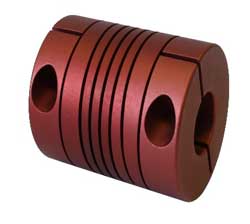
Posted to News on 21st Aug 2007, 16:35
Couplings help cut energy consumption - and carbon footprint
This article from Abssac argues that something as apparently simple as a flexible shaft coupling can help manufacturers reduce energy consumption and, therefore, work towards the ideal of a carbon-neutral factory.

In essence it is all down to how efficiently the coupling transmits the required torque through a given misalignment. Energy is lost in numerous ways, as couplings accommodate the three main shaft misalignments of angular, parallel or skewed.
In most shaft coupling designs the misalignment is taken up by a series of pins or sliding surfaces that transfer the load and torque as the coupling rotates. These couplings normally comprise many parts, all of which absorb energy as they move. However insignificant this energy loss may be when looked at singularly, when a factory has thousands of shaft couplings within its machinery, the total energy loss due to inefficiency can be quite substantial.
The helical beam coupling is an advanced design that generally exceeds the capabilities of common flexible shaft couplings. Since it is manufactured from one piece of material, there are no moving parts that slide or require movement as the shaft misalignments are simultaneously absorbed. The Helical coupling, by the nature of its design, is constant in its torque delivery and has low rail loads during rotation. It does not require lubrication and is silent during operation (noise being an indication of energy loss in other coupling designs).
Tailored designs
For each helical beam coupling, the performance capability is determined by six major characteristics: flexure outside diameter, inside diameter, coil thickness, material, number of coils, and number of starts. By altering these characteristics, torque capacity, angular and parallel misalignment capabilities, and torsional stiffness rates can be modified to suit specific specifications. Uniquely, flexible shaft couplings can then be tailored to the application, saving energy in manufacturing and ensuring that the correct part for the application is supplied each time.
For example, why use a larger than required shaft coupling that will require a larger motor to drive or indeed stop? The fact that the helical beam coupling is extensively used in space programmes is a testament to its low energy requirements.
Chris Cattle of Abssac states: "Within the carbon-neutral factory, the total energy required to rotate many helical beam couplings would be significantly lower than the energy required to rotate other multipart coupling designs."
For more information about helical beam shaft couplings, go to www.abssac.co.uk/Products/Rotary-products/112/Helical_shaft_couplings.html.






























